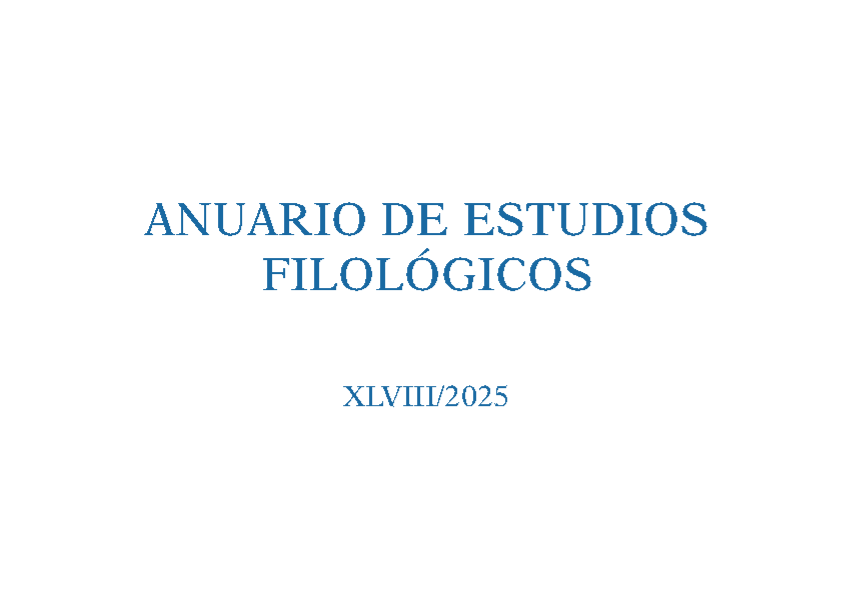"We make guilty of our disasters the sun, the moon, and the stars": a semantic mapping of Shakespeare's astronomical language
DOI:
https://doi.org/10.17398/2660-7301.48.281Keywords:
Shakespeare, Semantics, Lexicon, AstronomyAbstract
Shakespeare’s language has been studied and analysed for centuries, including monographs on the most disparate semantic fields –such as botany, geography, commerce, etc. In this regard, astronomical language is no exception. However, existing studies of Shakespeare’s astronomical language have either leaned towards the field of astrology and the symbolism of the occult or focused on glossing specific passages and terms, usually to disentangle the scientific value of astronomical references. Therefore, there is no systematic account of the semantics of these terms. Thus, the purpose of this study is to provide a holistic analysis of the three most common terms with a strictly astronomical meaning in Shakespeare’s lexicon, namely, ‘sun’, ‘moon’, and ‘star/s’. The analysis here maps the semantics of these terms by looking into the recurring meanings that they take. This, in turn, opens a new avenue of research into the stylistic utilization of astronomical bodies in ways that include character delineation, plot development, dramatic structure, gender characterization, and the role of figurative language at large.
Downloads
References
ADAMSON, Sylvia (1999): «Literary Language». In Lass, Roger (ed.): The Cambridge History of the English Language. Volume III: 1476 to 1776. Cambridge: CUP, 539-653.
BEVINGTON, David (ed.) (1997): The Complete Works of Shakespeare. New York: Longman.
BEZZOLA LAMBERT, Ladina (2002): Imagining the Unimaginable: The Poetics of Early Modern Astronomy. Amsterdam: Rodopi.
CAMPION, Nicholas (2014): «The Legacy of Classical Cosmology in the Renaissance: Shakespeare and Astronomy». Mediterranean Archaeology and Archaeometry, 14.3, 331-339.
CONLEY, C. H. (1915): «An Instance of the Fifteen Signs of Judgment in Shakes-peare». Modern Language Notes, 30.2, 41-44 (https://doi.org/10.2307/2916899).
COSTELLO, Priscilla (2016): Shakespeare and the Stars: The Hidden Astrological Keys to Understanding the World’s Greatest Playwright. Lake Worth, FL: Ibis Press.
CULPEPER, Jonathan (2011): «A New Kind of Dictionary for Shakespeare’s Plays: An Immodest Proposal» (Ravassat & Culpeper, 2011: 58-83).
DASTON, Lorraine (1991): «Marvelous Facts and Miraculous Evidence in Early Modern Europe». Critical Inquiry, 18.1, 93-124.
DEAN, John Candee (1924): «The Astronomy of Shakespeare». The Scientific Monthly, 19.4, 400-406.
GERARD, John (1636): The Herball or Generall Historie of Plantes. London: Printed by A. Islip, J. Norton & R. Whitakers (available at: https://archive.org/details/herballorgeneral00gera).
GILLESPIE, Stuart & RHODES, Neil (2006): «Introduction: Shakespeare and Elizabethan Popular Culture». In Gillespie, Stuart & Rhodes, Neil (eds.): Shakespeare and Elizabethan Popular Culture. London: Bloomsbury, 1-17.
GLÄSER, Rosemarie (1998): «The Stylistic Potential of Phraseological Units in the Light of Genre Analysis». In Cowie, A. P. (ed.): Phraseology: Theory, Analysis, and Applications. Oxford: OUP, 125-143.
GUTHRIE, William Gilmour (1964): «The Astronomy of Shakespeare». The Irish Astronomical Journal, 6.6, 201-211.
HARMON, Orrin E. (1898): «The Astronomy of Shakespeare». Popular Astrono-my, 6, 232-233.
HOPE, Jonathan (2010): Shakespeare and Language: Reason, Eloquence and Artifice in the Renaissance. London: Bloomsbury.
JABLONSKI, Nina G. (2012): Living Color: The Biological and Social Meaning of Skin Color. Berkeley: University of California Press.
KANAZAWA, Satoshi & LI, Norman P. (2018): «The Savanna Theory of Happi-ness». In Hopcroft, Rosemary L. (ed.): The Oxford Handbook of Evolution, Biology, and Society. Oxford: OUP, 171-194 (https://doi.org/10.1093/oxfordhb/9780190299323.013.48).
LEVY, David H. (2011): The Sky in Early Modern English Literature: A Study of Allusions to Celestial Events in Elizabethan and Jacobean Writing, 1572–1620. New York: Springer.
LEVY, David H. & HAYDEN, Judy A. (2016): «An English Renaissance Astronomy Club? Shakespeare, Observation and the Cosmos». In Hayden, Judy A. (ed.): Literature in the Age of Celestial Discovery: From Copernicus to Flamsteed. New York: Palgrave, 75-90 (https://doi.org/10.1007/978-1-137-56803-8_4).
MCCORMICK-GOODHART, Leander (1945): «Shakespeare and the Stars». Popular Astronomy, 53.10, 489-502.
MUIR, Kenneth (1977): The Sources of Shakespeare’s Plays. New Haven: Yale University Press.
NACISCIONE, Anita (2010): Stylistic Use of Phraseological Units in Discourse. Amsterdam: John Benjamins.
OED = Oxford English Dictionary. Oxford: OUP (on-line: https://www.oed.com/).
OLSON, Donald W. (2014): Celestial Sleuth: Using Astronomy to Solve Mysteries in Art, History and Literature. New York: Springer (https://doi.org/10.1007/978-1-4614-8403-5).
PAOLUCCI, Anne (1977): «The Lost Days in A Midsummer Night’s Dream». Shakespeare Quarterly, 28.3, 317-326.
POPPER, Nicholas (2006): «“Abraham, Planter of Mathematics”: Histories of Mathematics and Astrology in Early Modern Europe». Journal of the History of Ideas, 67.1, 87-106.
RAVASSAT, Mireille (2011): «‘a thing inseparate/Divides more wider than the sky and earth’ – of Oxymoron in Shakespeare’s Sonnets» (Ravassat & Culpeper, 2011: 165-191).
RAVASSAT, Mireille & CULPEPER, Jonathan (eds.) (2011): Stylistics and Shakes-peare’s Language: Transdisciplinary Approaches. London: Continuum.
ROSS, Charles (1974): Edward IV. Berkeley: University of California Press.
SCHANZER, Ernest (1955): «The Moon and the Fairies in A Midsummer Night’s Dream». University of Toronto Quarterly, 24.3, 234-246.
SMIDT, Kristian (1986): Unconformities in Shakespeare’s Early Comedies. London: Macmillan.
SONDHEIM, Moriz (1939): «Shakespeare and the Astrology of His Time». Journal of the Warburg Institute, 2.3, 243-259.
USHER, Peter D. (2002): «Shakespeare’s Support for the New Astronomy». The Oxfordian, 5, 2-16.
USHER, Peter D. (2018): «Shakespeare’s Antony and Cleopatra and the New Astro-nomy». Notes and Queries, 65.1, 81-83 (https://doi.org/10.1093/notesj/gjx222).



